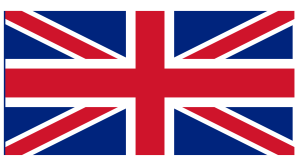Inquiring minds want to know, what will the British flag look like if the Scots scoot? Well, it will look like this:
 The reason involves one of the most famous creative heraldic hacks in history. If you look at paintings of British battles and ships before 1808, you will see that the Union Jack had only a white X, not a red one. More precisely, Azure, the Cross Saltire of St Andrew Argent [the Scottish cross] surmounted by the Cross of St George Gules, fimbriated of the second. This means, “on a blue field, a white X behind a red cross, the latter edged with white”. The white border on the red cross is required by the rule that metals (white/silver and yellow/gold) may not touch each other, nor may colors (red, blue, purple, orange, black, green). Most baseball caps obey this rule, but incomprehensibly, the Mets and Giants take the field with non-compliant caps, an enduring scandal.
The reason involves one of the most famous creative heraldic hacks in history. If you look at paintings of British battles and ships before 1808, you will see that the Union Jack had only a white X, not a red one. More precisely, Azure, the Cross Saltire of St Andrew Argent [the Scottish cross] surmounted by the Cross of St George Gules, fimbriated of the second. This means, “on a blue field, a white X behind a red cross, the latter edged with white”. The white border on the red cross is required by the rule that metals (white/silver and yellow/gold) may not touch each other, nor may colors (red, blue, purple, orange, black, green). Most baseball caps obey this rule, but incomprehensibly, the Mets and Giants take the field with non-compliant caps, an enduring scandal.
Upon the Act of Union with Ireland, it was necessary to add St. Patrick’s cross, a red saltire. If this were centered, St. Andrew’s cross would disappear, becoming a mere fimbriation of the Irish saltire. Placing the latter off-center as though slightly rotated, making St. Andrew’s cross an element in its own right, (given that the implied mess at the center crossing is hidden by the English cross), was a stroke of near genius and to my knowledge completely original in heraldic gimmickry.
If the white cross is removed, all that is necessary is to recenter the red saltire of (Northern) Ireland in its obligatory white border, hence the figure above: Azure, the Cross Saltire of St Patrick Gules, fimbriated Argent, surmounted by the Cross of St George Gules, fimbriated of the third.
AndrewSabl says
Brilliant! But Mike: doesn't this give a boost to the "Yes" vote-i.e. by demonstrating that if Scotland leaves, nobody except SameFacts readers will notice the difference to the flag?
PeterInDC says
Why would the blue field remain? It came from St. Andrew's cross, and there's no blue in the English or Irish crosses.
JamesWimberley says
But see below, for pre-Union Ireland and Plantagenet France.
James Wimberley says
There is precedent for just leaving the saltire in. We English stole Scotland fair and square, several times, and the Scots will come back, begging on their chilblained kilted knees to the dirge of their bagpipes.
The Royal Standard kept the fleur-de-lis until 1801, when George III abandoned the claim to the throne of France. (The little white horse had wandered in from Hanover. It trotted home in 1837, when Queen Victoria, being a mere woman, could not inherit the electorate.) Perhaps he felt sorry for the exiled French monarch, living at times as his guest. Perhaps it was a little awkward technically to be fighting a huge war with Revolutionary France and not trying to enforce the old claim - SFIK British war aims did not include restoration of the Bourbons either until quite late under Napoleon.
PS: Does the current Union Jack have a proper heraldic description? I doubt it, seeing that it is a clever hack, not Real Heraldry. At the time, the Admiralty just ordered its ships to fly the new flag from January 1 1801 “according to the Draught thereof marked (C)”.
TheHersch says
In 1837, Hanover was a kingdom. It stopped being an electorate when the HRE was abolished in 1806.
James Wimberley says
Your
ExcellencyRoyal Highness! My most abject apologies!Mitch Guthman says
I still don't understand the justification for the inclusion of blue elements. Presumably by agreeing to have the vote, England is renouncing all claims to Scotland in advance of the decision by Scotland to leave the union.
Perhaps the new flag should feature a dragon.
TheHersch says
If Scotland becomes independent, what of the monarchy? It seems to me it would be the perfect occasion to restore the Stuart heir, currently the head of the Wittelsbach family, Franz, the so-called Herzog von Bayern.
Mitch Guthman says
Nobody seems to know what the queen's role, if any, will be. Sometimes the SNP says Scotland will keep the status quo queen, sometime the queen will be a vestige like in Australia or Canada, sometimes Scotland will be a republic. Why not toss a Stuart restoration into the mix?
Apparently, the question of Scotland's form of government has been put in the big pile of stuff, great and small, to be worked out starting on Friday (currency, who gets oil revenues, whether the UK gets repaid for development costs, Scotland's share of the national debt,membership in NATO, membership in EU, status of Scottish people in the rump UK, open borders or not, viability of a Scottish NHS,etc).
NoGatorFan says
Seems like a before and after pic would make this clearer (to me at least).